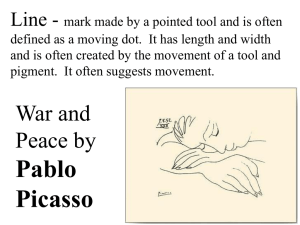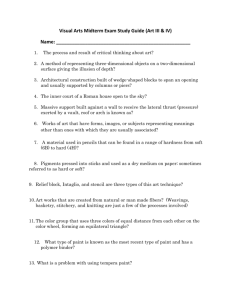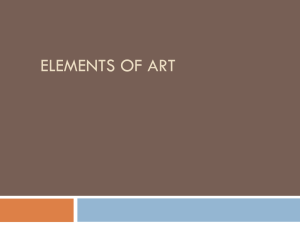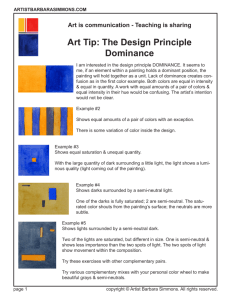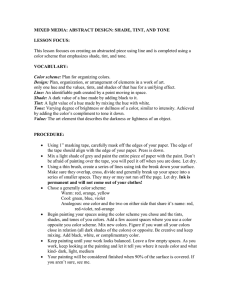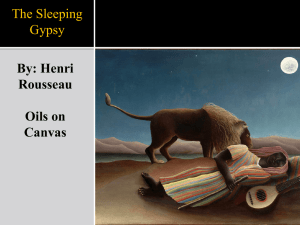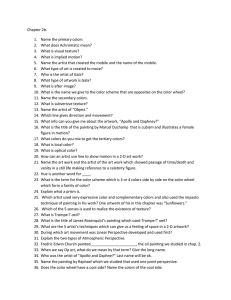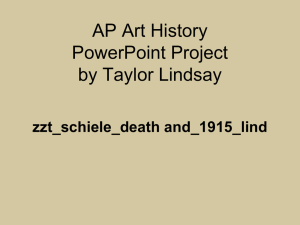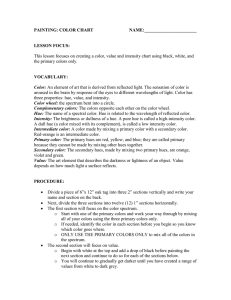color
advertisement
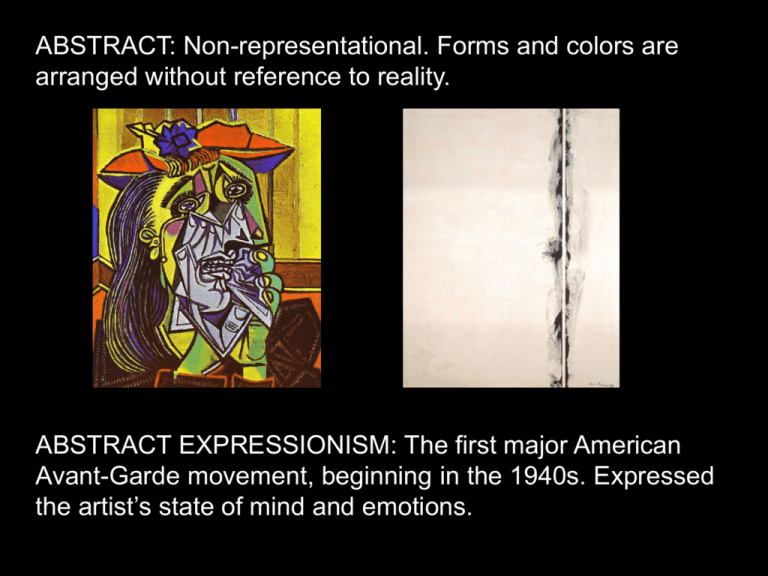
ABSTRACT: Non-representational. Forms and colors are arranged without reference to reality. ABSTRACT EXPRESSIONISM: The first major American Avant-Garde movement, beginning in the 1940s. Expressed the artist’s state of mind and emotions. CHIAROSCURO The treatment and use of light and dark to produce the effect of modeling. SFUMATO “Smoky.” A smokelike haziness that softens the outlines in a painting. ATMOSPHERIC/AERIAL PERSPECTIVE Creating the illusion of distance by variations in color intensity and line definition. MEDIUM (pl. MEDIA) The material an artist uses to create a work. LINEAR PERSPECTIVE All parallel lines converge at one or more vanishing points (also called one-point perspective or multiple-point perspective). Contains a horizon line and multiple orthogonal lines. Creates spatial depth through use of geometry. COLOR Includes hue, value, and saturation. HUE Hue and color are interchangeable terms. PRIMARY colors are red, yellow, and blue SECONDARY COLORS are the combination of two primary colors INTERMEDIATE (TERTIARY) COLORS are the combination of a primary color and a secondary color COLOR THEORY ADDITIVE COLOR: Color created by mixing colors of light SUBTRACTIVE COLOR: Color created by mixing colors of pigment Analogous Complimentar y Monochromati c COMPOSITION The arrangement of formal elements in a work. CONTRAPPOSTO The disposition of the human figure in which one part is turned in opposition to another part (usually hips and legs one way, shoulders and chest another), creating a counterpositioning of the body about its central axis. Sometimes called the “weight shift” because the weight of the body tends to be thrown to one foot, creating tension on one side and relaxation on the other. CONCEPTUAL ART An American avant-garde movement of the 1960s whose premise was that the “artfulness” of art lay in the artist’s idea rather than its final expression. POSTMODERNISM A reaction against modernist formalism, seen as elitist. Rejects tenets of all previous artforms but often references the past. Questions everything; seeks to destroy knowledge. PHOTOGRAPHY 1826: The first permanent photograph (Nicéphore Niépce) 1889: Jacques Louis Mandé Daguerre reveals the Daugerrotype, predecessor of the photograph Portrait of Daugerre DIVINE PROPORTION / GOLDEN RATIO The ratio of two quantities is equal to the ratio of their sum to the whole. BAROQUE The dominant European style from approximately 16001750. Features dramatic lighting and elaborate ornamentation. TENEBRISM Painting in the “shadowy manner,” using violent contrasts of light and dark. SPACE 1. The literal space a work occupies, as in sculpture. 2. Illusionistic space, created on a two-dimensional plane. 3. Negative space, intentionally left “empty.” LINE The extension of a point along a path, made concrete in art by drawing or chiseling into a plane. May be invisible, drawing the eye through the composition. May be tangible, as in contour lines. CLAUDE MONET IMPRESSIONISM: The first “language” of Modern Art. Sought to capture a fleeting moment to express the impermanent nature of life, space, and time. Self-Portrait with a Beret JAMES ABBOTT McNEILL WHISTLER AESTHETICISM: “Art for art’s sake” TONALISM: An aesthetic approach aimed at creating harmony and elegance. Predecessor of Impressionism. Music: Symphonies, Nocturnes, etc. NATURALISM The core of the Classical tradition. The style of painted or sculptured representation based on close observation of the natural world. REALISM A movement that emerged in mid-19th-century France. Realist artists represented the subject matter of everyday life in naturalistic style, especially subject matter previously considered inappropriate for artistic depiction. NEOCLASSICISM A style of art and architecture that emerged in the late 18th century as part of a revival of interest in classical cultures. Neoclassical artists adopted themes and styles from ancient Greece and Rome. ROMANTICISM A Western cultural phenomenon from about 1750 to 1850 (reaching its height in 1800-1840). Gave precedence to feeling and imagination over reason and thought. TROMPE L’OEIL French, “the fool’s eye,” A form of illusionistic painting that aims to deceive viewers into believing they are seeing real objects. ART NOUVEAU “New art.” Characterized by biomorphic (organic) shapes and a focus on aesthetic harmony. Austria and Germany: Jugendstil Spain: Modernismo Italy: Floreale Victor Horta: Tassel House, Brussels POP ART Term coined by British art critic Richard Alloway to refer to art, first appearing in the 1950s, that incorporated elements from consumer culture, mass media, and popular culture. READING ASSIGNMENT FOR WEEKS 6 AND 7 How to Look at a Painting Chapter three, Analysing Distortions to the Visible World” When Art Really Works Reclining Woman with Green Stockings, Egon Schiele Wheat Field with Crows, Vincent van Gogh The Man with the Puffy Face, Vincent van Gogh Boats in the Harbor at Collioure, André Derain Still Life with Apples, Paul Cézanne Bathers at Ansières, Georges-Paul Seurat After the Bath, Woman Drying Herself, Edgar Degas Les Demoiselles d’Avignon, Pablo Picasso Guernica, Pablo Picasso The Origin of the Milky Way, Jacopo Tintoretto The Virgin and Child, Masaccio
